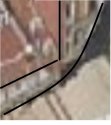It is not building the hull. It is building what is inside the hull, namely the decks and floors. There is no crane access to the center of the ship or of the modules by placing the rails at the door or at the sides of the building. They have to to right over the ship. Not to mention those bars themselves prevent access to the ship by a crane higher than them. That is why it is unreasonable to assume you can lower something through those bars when they are in place. In addition to bracing the left and right bulkheads to the keel, the bars might possible support an overhead crane that goes lengthwise through the ship with material being deposited at the fore of the ship, then craned to the center or aft of the ship. While the method is unusual, the shipyard is already unusual and appears to be innovating its own techniques unique from other shipyards.
Check your eyes. Here is the other end of it and there is no rail there. Given that the sheds are not interconnected, where does the rail get the originating goods and how do you suppose it can land them in the middle of the ship. I see putting a rail there as making no sense at all. There is no point where you are picking up the goods, and it does not go overhead where you want it to be. In addition, all those braces are blocking access. The height of the "rail" point isn't sufficient to clear the brace.
The bulkheads are definitely those from a warship. There is absolutely fracking no way that the design of the bulkheads and the shape of the hull and keel is that of a merchant ship.
Check all those commercial ships. They are not made with support girders. Don't mistake the structures that are meant to support the decks of container ships as support girders. Those "bridges" are not meant to support the construction of the ship; they are part of the ship itself that is meant to support the deck, were over 20,000 containers are going to be laid upon.
Be careful not to use the term "Shanghai" because Hudong Zhonghua is in the middle of Shanghai and they're the ones making the 075, 071, 054A and 056 that don't seem to be built in this manner.
From what I can see, the keel, left and right bulkheads are complete on these modules, and you are building what is inside those modules. Why put a shed in the first place if the shed prevents the gantry crane from moving things into the ship? The shed is there to control the temperature of each module to prevent deformation from thermal contraction and expansion. That is already looking like they are preparing to weld the modules together and that is not very early construction stages. The braces might be there to prevent additional deformation of the modules, and the bulkheads are likely to have been fabricated from another place before they were transported there. If the welding is done, they may lift the shed and the braces, and the gantry can move and lay larger items into the hull.
This is different from 002, where in the inside of the ship built first over the keel before the bulkheads were placed on the sides. So 002 is more likely built from the inside to out, whereas in 003, the ship appears built from the outside first to in.
So, I suggest the next : get a set of LEGO, and try to construct the ship with the method suggested by you ,
IT will be quite obvious it is not possible to do with cranes attached to the ship structure, due to the reasons I described before.
Don't take it as offence, I kept training in the past with LEGO to engineering managers, to explain things like this . (It is not so effective, the best training is the "go down to the shoplfoor and do it" : ) ) .
The shed visibly has a crane , check this :

The grey protrusion is the support of the crane rail on both side.
The white dot on the left, and the white line parallel with the shed movement axis is the rail of the crane.
The two strip hanging down is from the crane.
The workflow should be for small parts :
-move the shed beyond the edge of the structure,
-move the parts under the shed
-pick them up and move them to the assembly position
The big crane require do move into position the really big things, like the bulkheads.
And generally, if you check the corners of the modules they are weak, not capable to withstand the torque generated by the very far centre of gravity and relatively central support.

Means the modules missing the perpendicular bulkheads (that should make the module rigid and strong enough to carry its own weight ) , means the construction is in the early phases.















